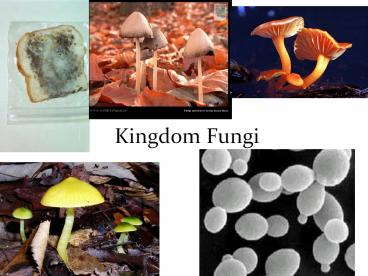Kingdom Fungi - PowerPoint PPT Presentation
1 / 8
Title:
Kingdom Fungi
Description:
Kingdom Fungi Fungi Reproduction Most fungi alternate reproducing sexually for one generation then asexually for the next generation Two Types of Asexual Reproduction ... – PowerPoint PPT presentation
Number of Views:248
Avg rating:3.0/5.0
Title: Kingdom Fungi
1
Kingdom Fungi
2
Fungi have recently been recognized as
evolutionarily closer to animals than plants.
3
Kingdom Fungi Characteristics
- 1) Cell wall made of chitin
- 2) Eukaryotic and multicellular
- 3) Classified by how they reproduce
- 4) Heterotrophs and major Decomposers
They feed by extracellular digestion. They
release digestive enzymes into their surroundings
and then absorb the digested nutrients into their
cells. Fungi must live on or near their food
source. Examples include mushrooms, moulds and
yeast.
4
- Basic Structure
- Most fungi are multicellular. Fungi are made up
of 2 main parts - Hyphae a network of fine filaments that make up
the body of the fungi - Mycelium a branching network of hyphae that
grow together underground
5
Fungi Reproduction
- Most fungi alternate reproducing sexually for
one generation then asexually for the next
generation - Two Types of Asexual Reproduction are
- Spores can be produced by mitosis. Spores are
windblown reproductive cells that can grow into a
new organism in a suitable environment. - Fragmentation pieces of hyphae break off and
grow into new mycelia
6
(No Transcript)
7
Sexual Reproduction
- Spores can also be produced sexually.
- Occurs when two hyphae of opposite types, called
mating strains and -, combine and fuse together
to form a zygospore. - A zygospore can develop into a new fungus. (See
figure 12.47 on page 453)
8
Classification of Fungi
- There are four major groups of fungi
- Zygospore fungi with sporangiophores
- Club fungi with basidiospores
- Sac fungi with ascophores
- Imperfect fungi with no sexual phase
- Fungi classification is changing rapidly with
DNA analysis.































